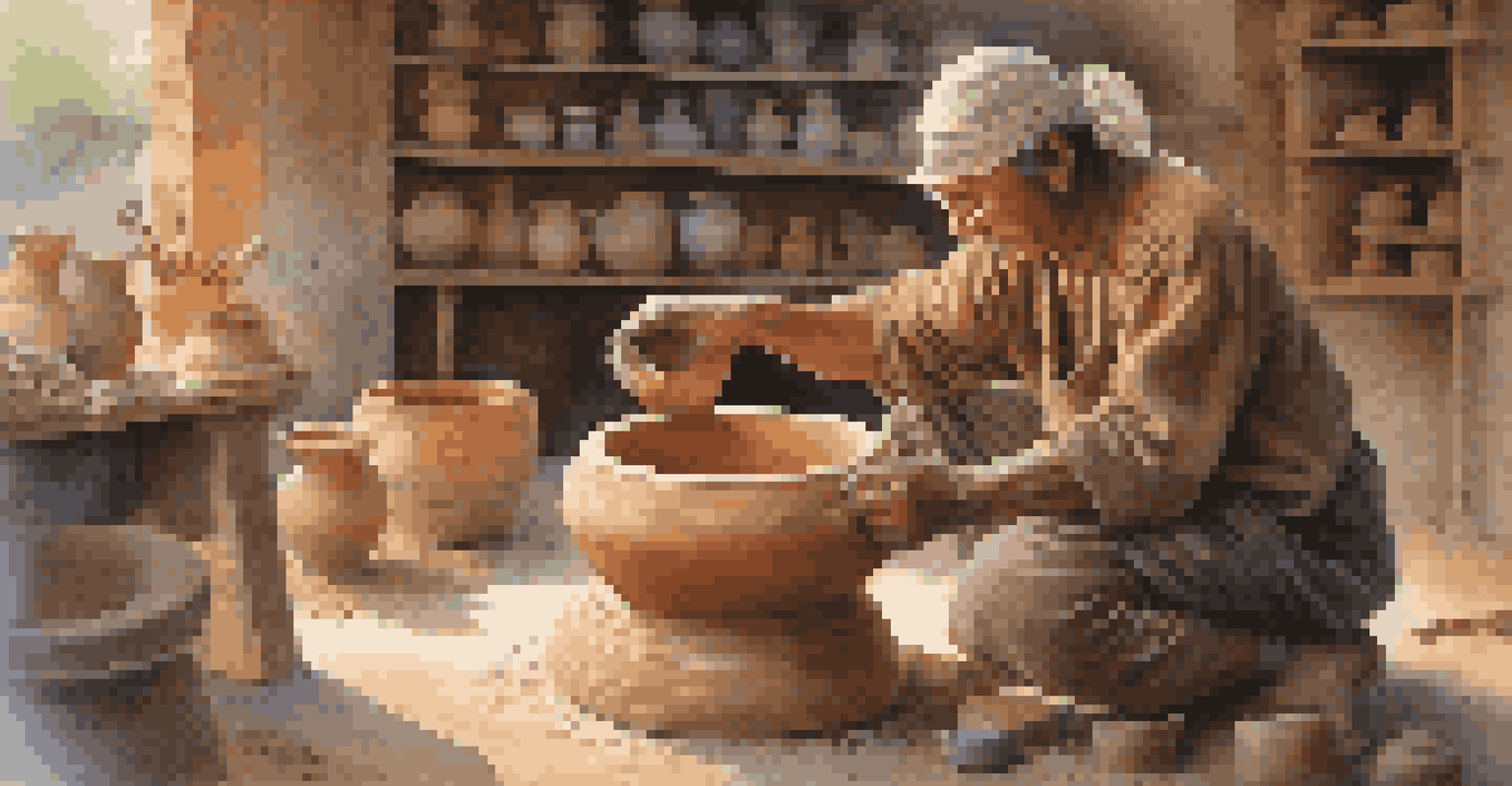Ceramics and Sustainability: Eco-Conscious Crafting Practices

Understanding Ceramics and Their Environmental Impact
Ceramics, while beautiful and functional, have a complex relationship with the environment. The traditional methods of making pottery often involve high energy consumption and significant waste. Understanding these impacts is the first step toward more sustainable practices in this art form.
We do not inherit the earth from our ancestors, we borrow it from our children.
Many ceramic artists and manufacturers are now aware of these issues and are seeking ways to minimize their ecological footprint. This includes everything from sourcing materials responsibly to employing energy-efficient kiln practices. By considering the entire lifecycle of their products, they can make a substantial difference.
For example, some artisans are choosing to use local clay, which reduces transportation emissions. Others are exploring alternative firing techniques that use renewable energy sources, like solar or wind. Each small change can contribute to a more sustainable approach to ceramics.
Eco-Conscious Sourcing of Materials
Sourcing materials responsibly is crucial in the pursuit of sustainability. Many ceramic artists now prioritize using natural, non-toxic materials that are locally sourced. This not only supports local economies but also reduces the carbon footprint associated with transporting materials over long distances.

For instance, artists might opt for clay that is abundant and sustainably harvested, avoiding overexploitation of resources. Additionally, some are experimenting with recycled materials, such as glass or porcelain, to create unique ceramic pieces while minimizing waste.
Sustainable Practices in Ceramics
Ceramic artists are increasingly adopting eco-friendly methods, such as responsible material sourcing and energy-efficient firing techniques, to minimize their environmental impact.
By being mindful of their material choices, ceramicists can significantly lessen their environmental impact. This eco-conscious sourcing reflects a growing trend in the industry towards sustainability, encouraging others to follow suit.
Sustainable Firing Techniques in Ceramics
Firing is a critical step in the ceramics process, typically requiring a lot of energy. However, sustainable firing techniques are emerging as a way to reduce this energy consumption significantly. For example, some artists are utilizing wood or alternative fuels instead of traditional gas or electric kilns.
Sustainability is not a destination, but a journey that requires us to be responsible stewards of our resources.
These alternative firing techniques not only lower energy use but also create unique aesthetic qualities in the final pieces. A wood-fired ceramic pot, for instance, may feature distinct color variations and textures that can’t be replicated in conventional kilns.
Moreover, some potters are adopting kiln designs that maximize fuel efficiency, such as the use of an anagama kiln or soda firing. These practices demonstrate how innovation in firing techniques can contribute to a more sustainable ceramics industry.
Embracing Zero Waste Practices
The zero waste movement is gaining traction in many industries, and ceramics is no exception. Artists are finding creative ways to minimize waste generated during the crafting process. For instance, leftover clay scraps can be recycled and reused, reducing the need for new materials.
Additionally, potters are becoming more resourceful with their packaging and shipping methods. Using biodegradable materials or repurposing boxes can significantly lower waste, making the entire production process more sustainable.
Education Drives Eco-Consciousness
Workshops and courses focused on sustainable practices are empowering both new and experienced artists to make informed, eco-friendly choices in their craft.
By adopting zero waste practices, ceramic artists not only contribute to environmental conservation but also inspire others in the community to rethink their own habits. This shift towards sustainability in ceramics illustrates the power of creativity in addressing ecological challenges.
The Role of Education in Sustainable Ceramics
Education plays a vital role in promoting sustainability within the ceramics community. Workshops and classes focused on eco-conscious practices can empower both emerging and established artists to make informed choices. An emphasis on sustainability in art education encourages students to think critically about their materials and methods.
Many institutions are now including sustainability as a core component of their curricula, teaching students about the environmental impacts of their craft. This knowledge fosters a new generation of artists who prioritize eco-friendliness in their work.
Furthermore, experienced artisans often share their sustainable practices through social media and community events, creating a network of support and inspiration. This collaborative spirit is essential for advancing sustainability in ceramics.
Community Initiatives Supporting Sustainable Ceramics
Community initiatives are vital in promoting sustainable ceramics practices. Local craft fairs, workshops, and exhibitions often highlight eco-conscious artists, providing them with a platform to showcase their work. These events not only raise awareness but also foster connections among artists and environmentally-minded consumers.
In many areas, there are also cooperatives that focus on sustainable materials and methods. By pooling resources, these groups can support local artisans in sourcing eco-friendly materials and sharing knowledge about sustainable practices.
Community Supports Sustainable Art
Local initiatives and cooperatives play a crucial role in promoting sustainable ceramics by connecting artists and consumers who share a commitment to eco-conscious practices.
Such community engagement not only strengthens the ceramics community but also encourages a cultural shift toward sustainability. When artists and consumers unite under a common goal, they can create a powerful movement for change.
Looking Ahead: The Future of Sustainable Ceramics
The future of ceramics looks promising as more artists and manufacturers embrace sustainability. With ongoing innovations in materials, techniques, and education, the industry is set to evolve in exciting ways. This evolution not only benefits the environment but also enriches the art of ceramics itself.
As consumer demand for sustainable products rises, artists who prioritize eco-conscious practices may gain a competitive edge. Their commitment to sustainability can resonate with consumers who value ethical craftsmanship, leading to a broader market for green ceramics.

Ultimately, the journey toward sustainable ceramics is just beginning. With collaboration, creativity, and a commitment to the environment, the ceramics community can forge a path that inspires future generations to create responsibly.